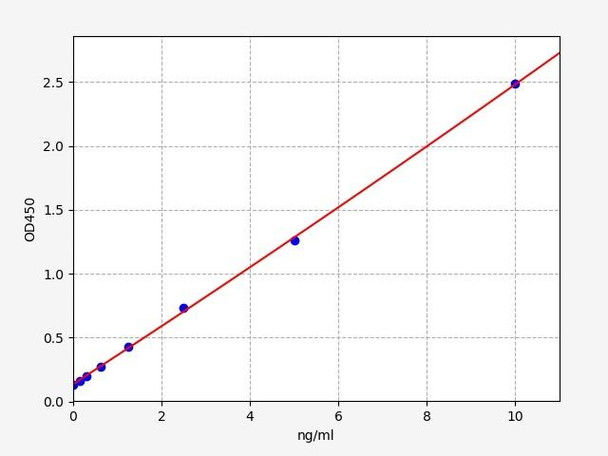Description
Human MAPKAPK2 (MAP kinase-activated protein kinase 2) ELISA Kit (HUFI03506)
The Human MAPKAPK2 (Map Kinase Activated Protein Kinase 2) ELISA Kit is a cutting-edge tool for the precise measurement of MAPKAPK2 levels in human samples such as serum, plasma, and cell culture supernatants. With its exceptional sensitivity and specificity, this kit delivers consistent and reliable results, making it an invaluable asset for various research purposes.MAPKAPK2 is a key player in cellular signaling pathways, being activated by MAP kinases to regulate cell growth, differentiation, and stress responses.
Dysregulation of MAPKAPK2 has been implicated in a variety of diseases, including cancer, inflammation, and neurodegenerative disorders, underscoring its importance as a potential therapeutic target and biomarker for disease progression.Trust in the Human MAPKAPK2 ELISA Kit to provide accurate and robust data for your research needs, offering insights into the role of MAPKAPK2 in disease pathogenesis and potential treatment strategies.
| Product Name: | Human MAPKAPK2 (MAP kinase-activated protein kinase 2) ELISA Kit |
| Product Code: | HUFI03506 |
| Size: | 96 Assays |
| Alias: | MAPKAP kinase 2 ELISA Kit, MAPKAPK 2 ELISA Kit, MAPKAPK2 ELISA Kit, MK2 ELISA Kit |
| Detection method: | Sandwich ELISA, Double Antibody |
| Application: | This immunoassay kit allows for the in vitro quantitative determination of Human MAPKAPK2 (MAP kinase-activated protein kinase 2) concentrations in serum plasma and other biological fluids. |
| Sensitivity: | < 0.094ng/ml |
| Range: | 0.156-10ng/ml |
| Storage: | 4°C for 6 months |
| Note: | For Research Use Only |
| Recovery: | Matrices listed below were spiked with certain level of Human MAPKAPK2 (MAP kinase-activated protein kinase 2) and the recovery rates were calculated by comparing the measured value to the expected amount of Human MAPKAPK2 (MAP kinase-activated protein kinase 2) in samples. | ||||||||||||||||
| |||||||||||||||||
| Linearity: | The linearity of the kit was assayed by testing samples spiked with appropriate concentration of Human MAPKAPK2 (MAP kinase-activated protein kinase 2) and their serial dilutions. The results were demonstrated by the percentage of calculated concentration to the expected. | ||||||||||||||||
| |||||||||||||||||
| CV(%): | Intra-Assay: CV<8% Inter-Assay: CV<10% |
| Component | Quantity | Storage |
| ELISA Microplate (Dismountable) | 8×12 strips | 4°C for 6 months |
| Lyophilized Standard | 2 | 4°C/-20°C |
| Sample/Standard Dilution Buffer | 20ml | 4°C |
| Biotin-labeled Antibody(Concentrated) | 120ul | 4°C (Protect from light) |
| Antibody Dilution Buffer | 10ml | 4°C |
| HRP-Streptavidin Conjugate(SABC) | 120ul | 4°C (Protect from light) |
| SABC Dilution Buffer | 10ml | 4°C |
| TMB Substrate | 10ml | 4°C (Protect from light) |
| Stop Solution | 10ml | 4°C |
| Wash Buffer(25X) | 30ml | 4°C |
| Plate Sealer | 5 | - |
Other materials and equipment required:
- Microplate reader with 450 nm wavelength filter
- Multichannel Pipette, Pipette, microcentrifuge tubes and disposable pipette tips
- Incubator
- Deionized or distilled water
- Absorbent paper
- Buffer resevoir
| UniProt Protein Function: | MAPKAPK2: a member of the MAPKAPK family of protein kinases. It is phosphorylated and activated by p38 in response to cytokines, stress and chemotactic factors.MAPKAPK-2 is apparently a direct target of p38 MAPK. HSP27 is one of its in vivo substrates. Two transcript variants encoding two different isoforms have been described. |
| UniProt Protein Details: | Protein type:Protein kinase, Ser/Thr (non-receptor); Kinase, protein; EC 2.7.11.1; Protein kinase, CAMK; CAMK group; MAPKAPK family; MAPKAPK subfamily Chromosomal Location of Human Ortholog: 1q32 Cellular Component: centrosome; cytoplasm; cytosol; nucleoplasm; nucleus Molecular Function:ATP binding; calcium-dependent protein serine/threonine kinase activity; calmodulin binding; calmodulin-dependent protein kinase activity; protein binding; protein kinase activity; protein serine/threonine kinase activity; signal transducer activity Biological Process: activation of MAPK activity; G2/M transition DNA damage checkpoint; inflammatory response; inner ear development; leukotriene metabolic process; MAPKKK cascade; peptidyl-serine phosphorylation; positive regulation of tumor necrosis factor biosynthetic process; protein amino acid autophosphorylation; protein amino acid phosphorylation; Ras protein signal transduction; regulation of interleukin-6 production; regulation of mRNA stability; regulation of tumor necrosis factor production; response to cytokine stimulus; response to DNA damage stimulus; response to lipopolysaccharide; response to stress; toll-like receptor signaling pathway; vascular endothelial growth factor receptor signaling pathway |
| NCBI Summary: | This gene encodes a member of the Ser/Thr protein kinase family. This kinase is regulated through direct phosphorylation by p38 MAP kinase. In conjunction with p38 MAP kinase, this kinase is known to be involved in many cellular processes including stress and inflammatory responses, nuclear export, gene expression regulation and cell proliferation. Heat shock protein HSP27 was shown to be one of the substrates of this kinase in vivo. Two transcript variants encoding two different isoforms have been found for this gene. [provided by RefSeq, Jul 2008] |
| UniProt Code: | P49137 |
| NCBI GenInfo Identifier: | 1346538 |
| NCBI Gene ID: | 9261 |
| NCBI Accession: | P49137.1 |
| UniProt Secondary Accession: | P49137,Q5SY30, Q5SY41, Q8IYD6, |
| UniProt Related Accession: | P49137 |
| Molecular Weight: | 42,203 Da |
| NCBI Full Name: | MAP kinase-activated protein kinase 2 |
| NCBI Synonym Full Names: | mitogen-activated protein kinase-activated protein kinase 2 |
| NCBI Official Symbol: | MAPKAPK2 |
| NCBI Official Synonym Symbols: | MK2; MK-2; MAPKAP-K2 |
| NCBI Protein Information: | MAP kinase-activated protein kinase 2 |
| UniProt Protein Name: | MAP kinase-activated protein kinase 2 |
| UniProt Gene Name: | MAPKAPK2 |
| UniProt Entry Name: | MAPK2_HUMAN |
*Note: Protocols are specific to each batch/lot. For the correct instructions please follow the protocol included in your kit.
Before adding to wells, equilibrate the SABC working solution and TMB substrate for at least 30 min at 37 °C. When diluting samples and reagents, they must be mixed completely and evenly. It is recommended to plot a standard curve for each test.
| Step | Protocol |
| 1. | Set standard, test sample and control (zero) wells on the pre-coated plate respectively, and then, record their positions. It is recommended to measure each standard and sample in duplicate. Wash plate 2 times before adding standard, sample and control (zero) wells! |
| 2. | Aliquot 0.1ml standard solutions into the standard wells. |
| 3. | Add 0.1 ml of Sample / Standard dilution buffer into the control (zero) well. |
| 4. | Add 0.1 ml of properly diluted sample ( Human serum, plasma, tissue homogenates and other biological fluids.) into test sample wells. |
| 5. | Seal the plate with a cover and incubate at 37 °C for 90 min. |
| 6. | Remove the cover and discard the plate content, clap the plate on the absorbent filter papers or other absorbent material. Do NOT let the wells completely dry at any time. Wash plate X2. |
| 7. | Add 0.1 ml of Biotin- detection antibody working solution into the above wells (standard, test sample & zero wells). Add the solution at the bottom of each well without touching the side wall. |
| 8. | Seal the plate with a cover and incubate at 37 °C for 60 min. |
| 9. | Remove the cover, and wash plate 3 times with Wash buffer. Let wash buffer rest in wells for 1 min between each wash. |
| 10. | Add 0.1 ml of SABC working solution into each well, cover the plate and incubate at 37 °C for 30 min. |
| 11. | Remove the cover and wash plate 5 times with Wash buffer, and each time let the wash buffer stay in the wells for 1-2 min. |
| 12. | Add 90 µL of TMB substrate into each well, cover the plate and incubate at 37 °C in dark within 10-20 min. (Note: This incubation time is for reference use only, the optimal time should be determined by end user.) And the shades of blue can be seen in the first 3-4 wells (with most concentrated standard solutions), the other wells show no obvious color. |
| 13. | Add 50 µL of Stop solution into each well and mix thoroughly. The color changes into yellow immediately. |
| 14. | Read the O.D. absorbance at 450 nm in a microplate reader immediately after adding the stop solution. |
When carrying out an ELISA assay it is important to prepare your samples in order to achieve the best possible results. Below we have a list of procedures for the preparation of samples for different sample types.
| Sample Type | Protocol |
| Serum | If using serum separator tubes, allow samples to clot for 30 minutes at room temperature. Centrifuge for 10 minutes at 1,000x g. Collect the serum fraction and assay promptly or aliquot and store the samples at -80°C. Avoid multiple freeze-thaw cycles. If serum separator tubes are not being used, allow samples to clot overnight at 2-8°C. Centrifuge for 10 minutes at 1,000x g. Remove serum and assay promptly or aliquot and store the samples at -80°C. Avoid multiple freeze-thaw cycles. |
| Plasma | Collect plasma using EDTA or heparin as an anticoagulant. Centrifuge samples at 4°C for 15 mins at 1000 × g within 30 mins of collection. Collect the plasma fraction and assay promptly or aliquot and store the samples at -80°C. Avoid multiple freeze-thaw cycles. Note: Over haemolysed samples are not suitable for use with this kit. |
| Urine & Cerebrospinal Fluid | Collect the urine (mid-stream) in a sterile container, centrifuge for 20 mins at 2000-3000 rpm. Remove supernatant and assay immediately. If any precipitation is detected, repeat the centrifugation step. A similar protocol can be used for cerebrospinal fluid. |
| Cell culture supernatant | Collect the cell culture media by pipette, followed by centrifugation at 4°C for 20 mins at 1500 rpm. Collect the clear supernatant and assay immediately. |
| Cell lysates | Solubilize cells in lysis buffer and allow to sit on ice for 30 minutes. Centrifuge tubes at 14,000 x g for 5 minutes to remove insoluble material. Aliquot the supernatant into a new tube and discard the remaining whole cell extract. Quantify total protein concentration using a total protein assay. Assay immediately or aliquot and store at ≤ -20 °C. |
| Tissue homogenates | The preparation of tissue homogenates will vary depending upon tissue type. Rinse tissue with 1X PBS to remove excess blood & homogenize in 20ml of 1X PBS (including protease inhibitors) and store overnight at ≤ -20°C. Two freeze-thaw cycles are required to break the cell membranes. To further disrupt the cell membranes you can sonicate the samples. Centrifuge homogenates for 5 mins at 5000xg. Remove the supernatant and assay immediately or aliquot and store at -20°C or -80°C. |
| Tissue lysates | Rinse tissue with PBS, cut into 1-2 mm pieces, and homogenize with a tissue homogenizer in PBS. Add an equal volume of RIPA buffer containing protease inhibitors and lyse tissues at room temperature for 30 minutes with gentle agitation. Centrifuge to remove debris. Quantify total protein concentration using a total protein assay. Assay immediately or aliquot and store at ≤ -20 °C. |
| Breast Milk | Collect milk samples and centrifuge at 10,000 x g for 60 min at 4°C. Aliquot the supernatant and assay. For long term use, store samples at -80°C. Minimize freeze/thaw cycles. |










